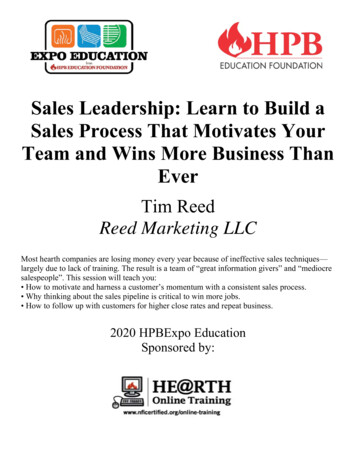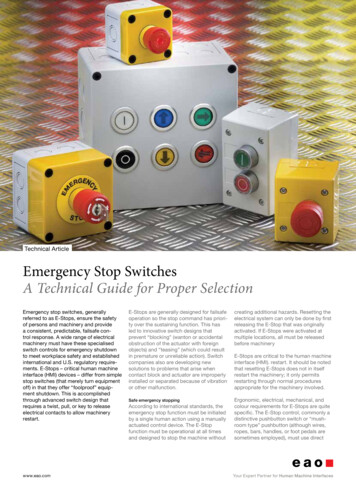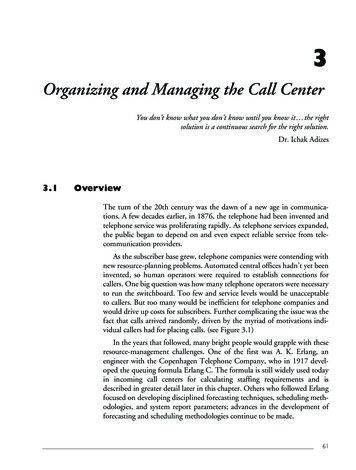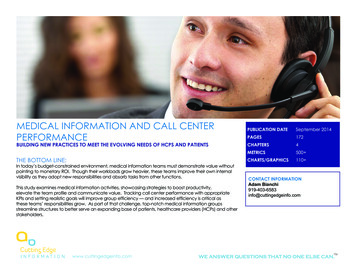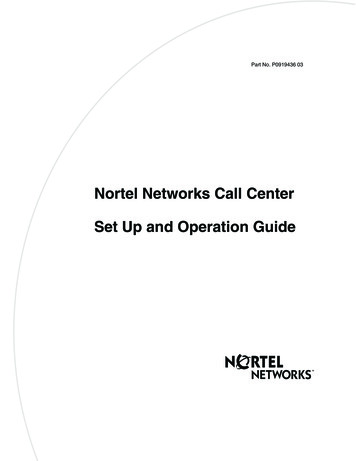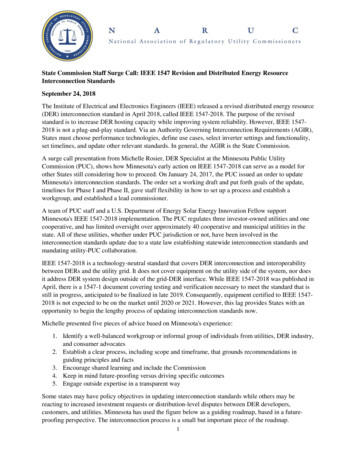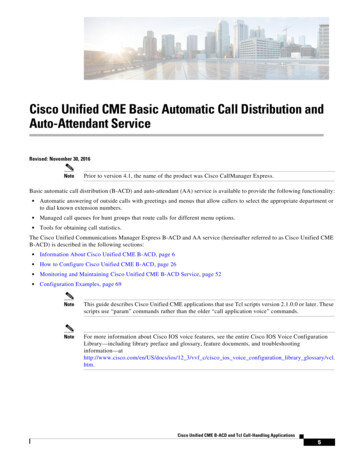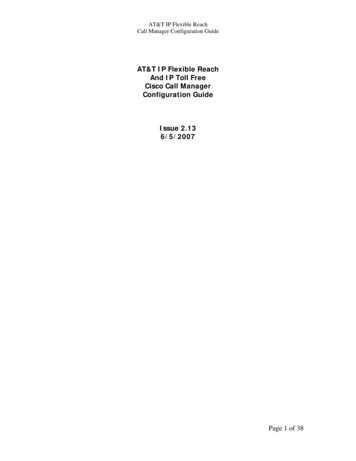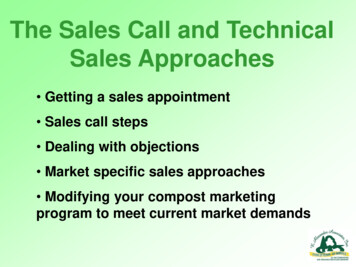
Transcription
The Sales Call and TechnicalSales Approaches Getting a sales appointment Sales call steps Dealing with objections Market specific sales approaches Modifying your compost marketingprogram to meet current market demands
Setting Appointments Goal – ‘sell’ appointment, not product Telephone calling– With and without contact name– Gain enough interest in your product (sell yourself)– Gain information - can also do during a ‘drive by’,‘cold call’» Get a mobile phone number for prospect, hourswhen in the office (available) Be brief on the telephone (and let them knowthe sales call will be brief)– They will give you more time if you peak theirinterest
Setting Appointments Getting past the secretary–Don’t act like a sales person»Use voice inflections–Try not to tell them to much (anything)–Speak as if the prospect is your friend»Give them your name as if theprospect knows you–Don’t answer any unasked questions–Don’t lieTougher without contacts (buyers) name
Scripts Points to make–Introduce yourself and company, thenproduct–Script tact–Ask for appointment / ‘drop buy’–Try to gain additional information –company related, schedule (when in office?)To be used on prospect, not secretary
Scripts Script tact–Third party ’I’m working with a lot of(customer type) with similar needs –‘Think I can save you money and help youprovide better results to your customers’–‘Will be in your area and was hoping I coulddrop off a sample and some literature’–‘I’ll be in the area tomorrow and I’d love tostop by and drop off a sample and someliterature’–Referral - thought you I shouldcall you
Sales Appointment &Closure Ratio The more prospects a salespersoncontacts, the more sales success theyare likely to achieve A salesperson’s activity usuallyimpacts their overall success– But mgt. needs to consider strengths /weaknesses of sales staff (get them help)In sales, you can only be certain of your own activity, notthe actions of the prospect! So, sales staff must activelyapproach the market on an on-going basis.
Telephone Calling Remember – you can’t ‘sell them’unless you get in front of them Goal – deflect questions and getappointment–Give details at the appointment, not thephone Be upbeat, brief, confident(you have something they need)And .
.watch yourattitude !
Sandler
Preparing for the Sales Call Be mentally and physically prepared beforeyou go into the sales appointment– Be mentally focused– Have any required supplies or tools(e.g. product samples, literature, analysis, pictures, end useresearch, etc.) Be dressed properly– Always try to dress at the same level or slightlyabove your prospect So, if the prospect wears a tie, then you wear a tie. However, ifthey are wearing a pair of jeans and a tee-shirt, then you shouldnot be in a suit and tie– Consider a company uniform
Preparing for the Sales Call Prospect background– Obtaining baseline data on a prospect is helpful– The greater the sales potential of the prospect,the more preparation you should do andknowledge you should have about them– Easier today with so many companies havingwebsites– You could even ask for a company brochure to beposted via reception (in order to minimize theeffort made by the prospect him/herself).
Sales Tools & Services Use/Availability of sales tools andservices improves success on a‘sales call’–Improves credibility of product(salesperson and company)–Illustrates professionalism–Provides customers with thetechnical assistance they require
Sales ToolsImprove ‘field’results Improves credibility ofproduct Illustrates professionalism Provide technical assistanceto customers
The Sales Call Be prepared – mentally, product and clientdata, tools Be a ‘problem solver’ – “technical sales” Listen – 2/3rds of the time they should betalking Buying is an emotional action– If they like you, they’ll buy from youRemember – repeat sales are the goal
Usingstandardised salespresentations arenot the mosteffective methodto make sales!
Sales Call Steps1. Gain rapport – bond, emotional connection, askprobing questions2. Identify the potential customers problems andneeds (3-5), identify ways to solve their problems– Once you find them, focus presentation onthem– Can go over list with prospect– Take notes !!3. Determine the cost of the problem and if money isavailable to solve the problems (buy your product)
Sales Call Steps4.Make sure you are talking to the decision-maker‒ Understand decision making process‒ Want ‘yes’ or ‘no’ answer (upfront contract)5. Complete the sales presentation‒ Illustrate a means of solving their problem(s),meeting their needs, or addressing theirconcerns – ask for the order6. Determine if potential customer has any objections.‒ If so, address them before leaving
Sales Call Rules Sales is a ‘numbers game’– Not everyone will buy Nurture prospect Don’t be afraid to ask for order Don’t get emotionally involved Remember that prospects lie Don’t look to get your ego massagedduring a sales call– Getting the sale, is the goal* Sales people take a ‘maybe’ instead of a ‘no’ Listen – let them talk .stay positive
Requirements of DifferentMarket Sectors Each market has its own nuances andrequirements Different uses, important benefits,aversions Understand them before approachingEXAMPLES
Markets Agriculture Erosion/Sediment Control Landscapers / Landscape Architect Reclamation Resellers-Outlined in my book- Consider ‘buyer’ psychology(why easier/harder to sell) Topsoil manufacturing Turf - General and Sports Turf Wholesale Nurseries
AgricultureBackground: Largest potential market, but greatly undeveloped Possess a great need for organic matter, but oftenuse their own materials (‘wastes’) Economic issue to use, compare compost tofertilizer (only nutrients) Typically won’t use compost additionally to otherinputs, must find a way to use as a replacement toother products Farmers are risk adverse, skeptical Certified organic and sustainable farming mayhelp
AgricultureCompost Uses: Soil incorporant for field crops, vegetables andfruit crop field Plasticulture/raised planting bedcomponent Hothouse crop media component Organic and/or certified organic fertilizerEconomics of use is tougher
AgricultureBenefits of Compost Use (sales points): Source of stabilized organic matter Provides more organic matter than cover crops Allows for faster plant growth and more extensiverooting Rich in plant nutrients (micro and macro) High cation exchange capacity Disease suppression of soil borne diseases Can increase crop yield Can increase fruit size
Investment invine / treehealthPerennial crops
LandscapersBackground: Probably largest ‘paying’ market forcompost Less risk adverse Like products versatility Availability, delivery reliability are key Cost and consistency Reduced ‘plant loss’
LandscapersCompost Uses: Garden bed establishment Planter mix component Tree/shrub backfill mix component Manufactured topsoil component Decorative plant mulch Turf establishment/renovation Turf topdressing Organic fertilizer
LandscapersBenefits of Compost Use (sales points): Lack of good topsoil available Less expensive than most peat, peat-humus andmulch products Rich in plant nutrients (micro and macro) Allows faster plant growth Promotes deeper rooting/better establishment One step turf and flower bed installation Less plant loss where compost is used intree/shrub establishment projects
ResellersBackground: May only resell, but some also use Various types, sizes – bulk vs. bags required Often look for unique product, and other ways, toimprove ‘traffic’ in their stores Can promote your products name (brand) Need to provide promotional tools, assistance Can be promoted as versatile, environmentallyfriendly product
ResellersCompost Uses: Resale for landscapeapplication Resale for general turf application Resale for erosion control applicationProduct aesthetics are key to this market
ResellersBenefits of Compost Use (sales points): Excellent profit margin Unique product Environment product Helps diversify product line Versatility and potential ‘in-house’usage of product In bulk form, limited competition(?)
Dealing with Objections Key to successful ‘selling’‒ Must understand product, the technical,financial and logistical issues Typical objections .examples? Keep your perspective‒ Often objections are ‘not real’, they’rejust not ready to buy‒ Some times they are just testing youHandout
General and SituationalObjections General‒ Example – ‘I can’t afford it .it’s too expensive’‒ Example – ‘I don’t believe in amending the soilbefore planting’ Situational‒ Example – ‘the pH and EC content is too high’‒ Example – ‘the product is too coarse to use astopdressing’
Unanswerable QuestionsOften used as objections or stalls What happens if . What happens after the product is in the soilfor 700 years? What happens if my dog eats it?Answer the best you can, but don’t lie !!It’s OK to say ‘that you don’t know’
Customer Follow-UpOnce you have customers, take care of them! Systematically monitor customers (rate them) It’s cheaper to keep a current customer than it is tofind a new customer Customers are not always right (are 95% of time)- Just treat them like they are Some customers are not worth having- 80/20 Rule
Developing Sales andMarketing Programs Programmes will direct sales efforts, as wellas standardize them (improve efficiency) Simple, but provide detail Well thought out, to enable you to meet yoursales goals
Marketing Program Components Sales Focus– Customer size, geographic area of concentration Pricing Policies (base price, discounts) Scheduling of Sales/Marketing Efforts– Seasonal concentration of sales efforts– Timing of advertising/promotional activities Sales Tools– Pitch pages, sales programs, product literature Lead Generation Associated Services Procedures for Contact Management (ranking,follow up) Sales GoalsDiscussed earlier More sophisticated plan
Sales Management Advice Minimize the amount of paperwork required for salesstaff to place an order and manage their job. Create systems that will allow them to be productive ‘inthe field’ Remember, in many companies, production and salesare placed in situations where they are at conflictAVOID / DIFFUSE If sales has sales goals, then management must helpthem to track progress Sales staff should understand that they should be activeafter the sale going to project sites to assure that theproduct is being used correctly, photograph projectsand gaining addition practical ‘field’ knowledge.
Sales Management ReportsSuggested ReportsFrequencySales totals by product - report should provide actual sales Bi-monthly orvolumes and invoicing ( ) totals, and should provide them both monthlyfor the current month and cumulative ‘year to date’Sales totals vs. budgeted sales - report should provide actual Monthlysales volumes and invoicing ( ) totals, and should provide themfor the current month and cumulative ‘year to date’ (andcompare them against sales projections)Sales totals by customer - report should provide actual sales As necessaryvolumes and invoicing ( ) totals, and should provide them bythe current month and cumulative ‘year to date’Overdue accounts reportSales totals ( ) vs. uncollected ( ) invoice totalsMonthlyMonthly orquarterlyMonthly and annual sales totals (by product) - should be placed Monthlyon a spreadsheet to compare sales trends from year to year*It would be helpful to be able to produce each of thesereports by sales region and / or salesperson
Now, that you’re operating asuccessful sales andmarketing program- Consider how to modify yourcompost marketing program to meetcurrent market demands
Modifying your Mktg. Strategies toMeet Current Market Conditions1. Compost marketing and sales strategies in tougheconomic times2. Not killing the end use markets by cheating3. Offering customers the ability to sell a new service,not having them just buy a new product4. Environmental trends that affect compost usage5. Economics and availability of competing products(e.g., fertilizer, pine bark)6. Plant / crop management trends (e.g., more peoplegrowing food in their backyards)To address changing market conditions, generateadditional revenue, more efficiently move inventoryNext level thinking
Marketing / Sales in ToughEconomic Times1. Watch costs, but don’t stop investing in marketdevelopment2. Adjust marketing efforts to approach more ‘open’markets3. Understand utilization trends (e.g., NC DOT stimulus )4. Don’t ruin “paying” markets in the process
Not Killing Markets by Cheating Don’t anger specifiers Meet project/applicationspecifications Provide consistent compostOthers may – you will have to deal with the ‘fall out’
Offering Customers the Abilityto Sell a New ServiceNew compost markets /marketing trends
Environmental Trends thatAffect Compost Usage
Economics & Availabilityof Competing Products
Plant / Crop ManagementTrends1.2.3.4.Natives (coarse compost)Food crops at homeEnergy cropsRegional ag. shifts
Conclusions Must be properly ‘engaged’ with the market Must invest - it will yield ‘returns’ if donecorrectly Continuous efforts – generate marketing /product momentum Complete appropriate efforts / be properlytrained Adjust program based on circumstancesaround you-Earlier examples
Questions ?
Marketing / Sales Problem
SCENARIOTHIS FACILITY IS HAVING TROUBLE MARKETINGTHEIR COMPOST:BIOSOLIDS COMPOSTING FACILITY (1995) Producing since 1981, ‘believe’ they produce 6,000 - 12,000 yd3 /annum Sells to all end users at 4.00/ yd3 Have 2 full-time employees to operate facility – supervisor isresponsible for composting facility and wastewater treatmentplant Product quality has varied. Loads trucks on Fridays (only).Ch
Telephone calling –With and without contact name –Gain enough interest in your product (sell yourself) –Gain information - can also do during a ‘drive by’, ‘cold call’ »Get a mobile phone number for prospect, hours when in the office (available) Be brief on the telephone (and let


